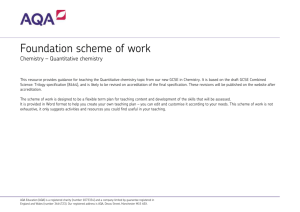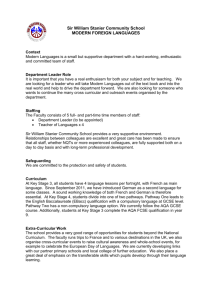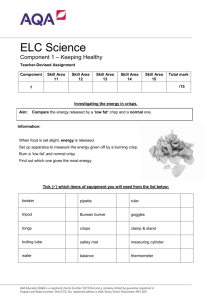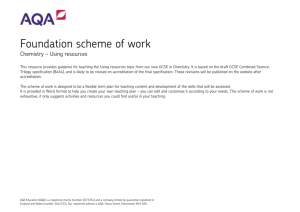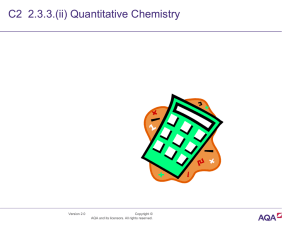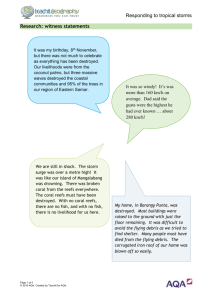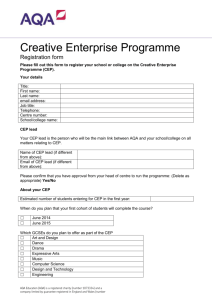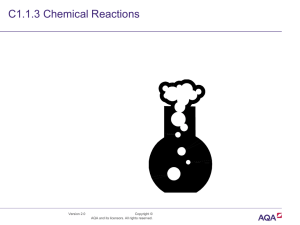GCSE Maths Revision Checklist: Number & Algebra
advertisement
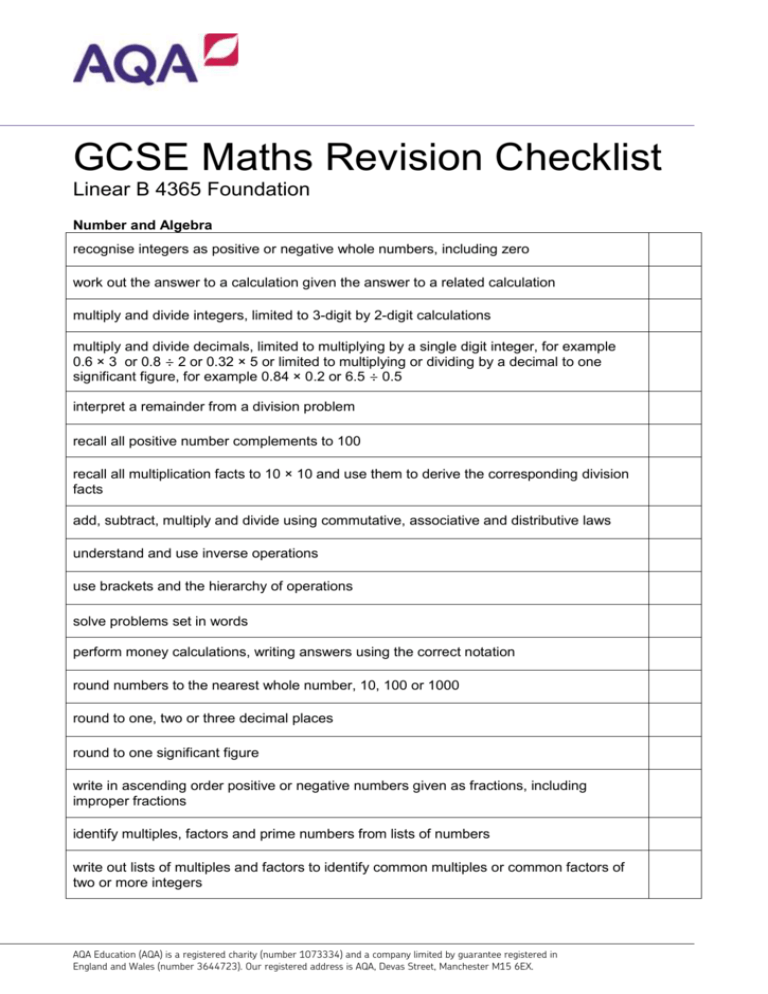
GCSE Maths Revision Checklist Linear B 4365 Foundation Number and Algebra recognise integers as positive or negative whole numbers, including zero work out the answer to a calculation given the answer to a related calculation multiply and divide integers, limited to 3-digit by 2-digit calculations multiply and divide decimals, limited to multiplying by a single digit integer, for example 0.6 × 3 or 0.8 ÷ 2 or 0.32 × 5 or limited to multiplying or dividing by a decimal to one significant figure, for example 0.84 × 0.2 or 6.5 ÷ 0.5 interpret a remainder from a division problem recall all positive number complements to 100 recall all multiplication facts to 10 × 10 and use them to derive the corresponding division facts add, subtract, multiply and divide using commutative, associative and distributive laws understand and use inverse operations use brackets and the hierarchy of operations solve problems set in words perform money calculations, writing answers using the correct notation round numbers to the nearest whole number, 10, 100 or 1000 round to one, two or three decimal places round to one significant figure write in ascending order positive or negative numbers given as fractions, including improper fractions identify multiples, factors and prime numbers from lists of numbers write out lists of multiples and factors to identify common multiples or common factors of two or more integers AQA Education (AQA) is a registered charity (number 1073334) and a company limited by guarantee registered in England and Wales (number 3644723). Our registered address is AQA, Devas Street, Manchester M15 6EX. write a number as the product of its prime factors and use formal and informal methods for identifying highest common factors (HCF) and least common multiples (LCM); abbreviations will not be used in examinations quote squares of numbers up to15 × 15 and the cubes of 1, 2, 3, 4, 5 and 10, also knowing the corresponding roots recognise the notation 25 and know that when a square root is asked for only the positive value will be required; candidates are expected to know that a square root can be negative solve such equations as x 2 = 25, giving both the positive and negative roots understand the notation and be able to work out the value of squares, cubes and powers of 10 use the index laws for multiplication and division of integer powers use calculators for calculations involving four rules use calculators for checking answers enter complex calculations, for example, to estimate the mean of a grouped frequency distribution, and use function keys for reciprocals, squares, cubes and other powers understand and use functions, including brackets +, , , ÷, x 2, x 3, x n, x, 3 x memory and understand the calculator display, knowing how to interpret the display, when the display has been rounded by the calculator and not to round during the intermediate steps of calculation interpret the display, for example for money interpret 3.6 as £ 3.60 or for time interpret 2.5 as 2 hours 30 minutes understand how to use a calculator to simplify fractions and to convert between decimals and fractions and vice versa identify equivalent fractions write a fraction in its simplest form simplify a fraction by cancelling all common factors, using a calculator where appropriate. For example, simplifying fractions that represent probabilities convert between mixed numbers and improper fractions AQA Education (AQA) is a registered charity (number 1073334) and a company limited by guarantee registered in England and Wales (number 3644723). Our registered address is AQA, Devas Street, Manchester M15 6EX. 2 of 19 compare fractions compare fractions in statistics and geometry questions add and subtract fractions by writing them with a common denominator convert mixed numbers to improper fractions and add and subtract mixed numbers convert between fractions and decimals using place value identify common recurring decimals know how to write decimals using recurring decimal notation understand whether a value is a percentage, a fraction or a decimal convert values between percentages, fractions and decimals in order to compare them; for example with probabilities use percentages in real-life situations interpret percentage as the operator ‘so many hundredths of’ work out percentage of shape that is shaded shade a given percentage of a shape interpret a fraction, decimal or percentage as a multiplier when solving problems use fractions, decimals or percentages to interpret or compare statistical diagrams or data sets convert between fractions, decimals and percentages to find the most appropriate method of calculation in a question; for example, finding 62% of £80 use fractions, decimals or percentages to compare proportions use fractions, decimals or percentages to compare proportions of shapes that are shaded use fractions, decimals or percentages to compare lengths, areas or volumes recognise that questions may be linked to the assessment of scale factor calculate a fraction of a quantity calculate a percentage of a quantity AQA Education (AQA) is a registered charity (number 1073334) and a company limited by guarantee registered in England and Wales (number 3644723). Our registered address is AQA, Devas Street, Manchester M15 6EX. 3 of 19 use fractions, decimals or percentages to find quantities use fractions, decimals or percentages to calculate proportions of shapes that are shaded use fractions, decimals or percentages to calculate lengths, areas or volumes calculate with decimals calculate with decimals in a variety of contexts, including statistics and probability apply the four rules to fractions using a calculator calculate with fractions in a variety of contexts, including statistics and probability work out one quantity as a fraction or decimal of another quantity understand and use unit fractions as multiplicative inverses multiply and divide a fraction by an integer, by a unit fraction and by a general fraction calculate a percentage increase or decrease calculate with percentages in a variety of contexts, including statistics and probability solve percentage increase and decrease problems use, for example, 1.12 Q to calculate a 12% increase in the value of Q and 0.88 x Q to calculate a 12% decrease in the value of Q work out one quantity as a percentage of another quantity use percentages to calculate proportions understand the meaning of ratio notation interpret a ratio as a fraction simplify ratios to the simplest form a : b where a and b are integers use ratios in the context of geometrical problems, for example similar shapes, scale drawings and problem solving involving scales and measures understand that a line divided in the ratio 1 of the whole : 3 means that the smaller part is one-quarter write a ratio in the form 1 : n or n : 1 AQA Education (AQA) is a registered charity (number 1073334) and a company limited by guarantee registered in England and Wales (number 3644723). Our registered address is AQA, Devas Street, Manchester M15 6EX. 4 of 19 interpret a ratio in a way that enables the correct proportion of an amount to be calculated use ratio and proportion to solve statistical and number problems use ratio and proportion to solve word problems using informal strategies or using the unitary method of solution solve best buy problems using informal strategies or using the unitary method of solution use direct proportion to solve geometrical problems use ratios to solve problems, for example geometrical problems use ratio and proportion to solve word problems use direct proportion to solve problems use notation and symbols correctly understand that letter symbols represent definite unknown numbers in equations, defined quantities or variables in formulae, and in functions they define new expressions or quantities by referring to known quantities understand phrases such as ‘form an equation’, ‘use a formula’ and ‘write an expression’ when answering a question recognise that, for example, 5x + 1 = 16 is an equation recognise that, for example V = IR is a formula recognise that x + 3 is an expression write an expression understand that the transformation of algebraic expressions obeys and generalises the rules of generalised arithmetic manipulate an expression by collecting like terms multiply a single term over a bracket write expressions to solve problems write expressions using squares and cubes factorise algebraic expressions by taking out common factors AQA Education (AQA) is a registered charity (number 1073334) and a company limited by guarantee registered in England and Wales (number 3644723). Our registered address is AQA, Devas Street, Manchester M15 6EX. 5 of 19 set up simple linear equations rearrange simple equations solve simple linear equations by using inverse operations or by transforming both sides in the same way solve simple linear equations with integer coefficients where the unknown appears on one or both sides of the equation or where the equation involves brackets set up simple linear equations to solve problems use formulae from mathematics and other subjects expressed initially in words and then using letters and symbols, for example formula for area of a triangle, area of a parallelogram, area of a circle, wage earned = hours worked x hourly rate plus bonus, volume of a prism, conversions between measures substitute numbers into a formula change the subject of a formula know the difference between solve simple linear inequalities in one variable represent the solution set of an inequality on a number line, knowing the correct conventions of an open circle for a strict inequality and a closed circle for an included boundary use a calculator to identify integer values immediately above and below the solution, progressing to identifying values to 1 decimal place above and immediately above and below the solution use algebraic expressions to support an argument or verify a statement generate common integer sequences, including sequences of odd or even integers, squared integers, powers of 2, powers of 10 and triangular numbers generate simple sequences derived from diagrams and complete a table of results describing the pattern shown by the diagrams work out an expression in terms of n for the n th term of a linear sequence by knowing that the common difference can be used to generate a formula for the n th term plot points in all four quadrants find coordinates of points identified by geometrical information, for example the fourth AQA Education (AQA) is a registered charity (number 1073334) and a company limited by guarantee registered in England and Wales (number 3644723). Our registered address is AQA, Devas Street, Manchester M15 6EX. 6 of 19 vertex of a rectangle given the other three vertices find coordinates of a midpoint, for example on the diagonal of a rhombus calculate the length of a line segment recognise that equations of the form y = mx + c correspond to straight line graphs in the coordinate plane plot graphs of functions in which y is given explicitly in terms of x or implicitly complete partially completed tables of values for straight-line graphs calculate the gradient of a given straight line using the y-step / x-step method plot a graph representing a real-life problem from information given in words or in a table or as a formula identify the correct equation of a real-life graph from a drawing of the graph read from graphs representing real-life situations; for example, the cost of a bill for so many units of gas or working out the number of units for a given cost, and also understand that the intercept of such a graph represents the fixed charge draw linear graphs with or without a table of values interpret linear graphs representing real-life situations, for example, graphs representing financial situations (eg, gas, electricity, water, mobile phone bills, council tax) with or without fixed charges, and also understand that the intercept represents the fixed charge or deposit plot and interpret distance–time graphs interpret line graphs from real-life situations, for example conversion graphs interpret graphs showing real-life situations in geometry, such as the depth of water in containers as they are filled at a steady rate interpret non-linear graphs showing real-life situations, such as the height of a ball plotted against time interpret any of the statistical graphs described in full in the topic ‘Data Presentation and Analysis’ specification reference S3.2 find an approximate value of y for a given value of x or the approximate values of x for a given value of y AQA Education (AQA) is a registered charity (number 1073334) and a company limited by guarantee registered in England and Wales (number 3644723). Our registered address is AQA, Devas Street, Manchester M15 6EX. 7 of 19 Statistics and Probability know the meaning of the term ‘hypothesis’ write a hypothesis to investigate a given situation discuss all aspects of the Handling Data Cycle within one situation decide whether data is qualitative, discrete or continuous and use this decision to make sound judgements in choosing suitable diagrams for the data understand the difference between grouped and ungrouped data understand the advantages of grouping data and the drawbacks distinguish between data that is primary and secondary understand how and why bias may arise in the collection of data offer ways of minimising bias for a data collection method write or criticise questions and response sections for a questionnaire suggest how a simple experiment may be carried out have a basic understanding of how to collect survey data understand the data-collection methods, observation, controlled experiment, questionnaire, survey and data logging know where the different methods might be used and why a given method may or may not be suitable in a given situation design and use data-collection sheets for different types of data tabulate ungrouped data into a grouped data distribution interrogate tables or lists of data, using some or all of it as appropriate design and use two-way tables complete a two-way table from given information draw any of the following charts or diagrams scatter graphs stem-and-leaf tally charts pictograms bar charts AQA Education (AQA) is a registered charity (number 1073334) and a company limited by guarantee registered in England and Wales (number 3644723). Our registered address is AQA, Devas Street, Manchester M15 6EX. 8 of 19 dual bar charts line graphs frequency polygons histograms interpret any of the types of diagram listed above obtain information from any of the types of diagram listed above draw composite bar charts as well as dual and bar charts understand which of the diagrams are appropriate for different types of data complete an ordered stem-and-leaf diagram use lists, tables or diagrams to find values for the following measures: median mean range mode model class find the mean for a discrete frequency distribution find the median for a discrete frequency distribution or stem-and-leaf diagram find the mode or modal class for frequency distributions calculate an estimate of the mean for a grouped frequency distribution, knowing why it is an estimate find the interval containing the median for a grouped frequency distribution choose an appropriate measure according to the nature of the data to be the ‘average’ find patterns in data that may lead to a conclusion being drawn look for unusual data values such as a value that does not fit an otherwise good correlation recognise and name positive, negative or no correlation as types of correlation recognise and name strong, moderate or weak correlation as strengths of correlation understand that just because a correlation exists, it does not necessarily mean that causality is present AQA Education (AQA) is a registered charity (number 1073334) and a company limited by guarantee registered in England and Wales (number 3644723). Our registered address is AQA, Devas Street, Manchester M15 6EX. 9 of 19 draw a line of best fit by eye for data with strong enough correlation or know that a line of best fit is not justified due to the lack of correlation use a line of best fit to estimate unknown values when appropriate compare two diagrams in order to make decisions about a hypothesis compare two distributions in order to make decisions about a hypothesis by comparing the range and a suitable measure of average such as the mean or median use words to indicate the chances of an outcome for an event use fractions, decimals or percentages to put values to probabilities place probabilities or outcomes to events on a probability scale work out probabilities by counting or listing equally likely outcomes estimate probabilities by considering relative frequency list all the outcomes for a single event in a systematic way list all the outcomes for two events in a systematic way use two way tables to list outcomes use lists or tables to find probabilities understand when outcomes can or cannot happen at the same time use this understanding to calculate probabilities appreciate that the sum of the probabilities of all possible mutually exclusive outcomes has to be 1 find the probability of a single outcome from knowing the probability of all other outcomes understand and use the term relative frequency consider differences where they exist between the theoretical probability of an outcome and its relative frequency in a practical situation understand that experiments rarely give the same results when there is a random process involved appreciate the ‘lack of memory’ in a random situation, for example a fair coin is still equally likely to give heads or tails even after five heads in a row AQA Education (AQA) is a registered charity (number 1073334) and a company limited by guarantee registered in England and Wales (number 3644723). Our registered address is AQA, Devas Street, Manchester M15 6EX. 10 of 19 understand that the greater the number of trials in an experiment the more reliable the results are likely to be understand how a relative frequency diagram may show a settling down as sample size increases, enabling an estimate of a probability to be reliably made; and that if an estimate of a probability is required, the relative frequency of the largest number of trials available should be used Geometry and Measures work out the size of missing angles at a point work out the size of missing angles at a point on a straight line know that vertically opposite angles are equal distinguish between acute, obtuse, reflex and right angles name angles estimate the size of an angle in degrees justify an answer with explanations, such as ‘angles on a straight line’, etc use one lower-case letter or three upper-case letters to represent an angle, for example x or ABC understand that two lines that are perpendicular are at 90o to each other draw a perpendicular line in a diagram identify lines that are perpendicular use geometrical language use letters to identify points, lines and angles understand and use the angle properties of parallel lines recall and use the terms alternate angles and corresponding angles work out missing angles using properties of alternate angles and corresponding angles understand the consequent properties of parallelograms understand the proof that the angle sum of a triangle is 180o AQA Education (AQA) is a registered charity (number 1073334) and a company limited by guarantee registered in England and Wales (number 3644723). Our registered address is AQA, Devas Street, Manchester M15 6EX. 11 of 19 understand the proof that the exterior angle of a triangle is equal to the sum of the interior angles at the other two vertices use angle properties of equilateral, isosceles and right-angled triangles use the angle sum of a quadrilateral is 360o calculate and use the sums of interior angles of polygons recognise and name regular polygons: pentagons, hexagons, octagons and decagons use the angle sum of irregular polygons calculate and use the angles of regular polygons use the sum of the interior angles of an n-sided polygon use the sum of the exterior angles of any polygon is 360o use interior angle + exterior angle = 180o use tessellations of regular and irregular shapes explain why some shapes tessellate and why other shapes do not tessellate recall the properties and definitions of special types of quadrilateral name a given shape identify a shape given its properties list the properties of a given shape draw a sketch of a named shape identify quadrilaterals that have common properties classify quadrilaterals using common geometric properties recall the definition of a circle identify and name these parts of a circle draw these parts of a circle understand related terms of a circle AQA Education (AQA) is a registered charity (number 1073334) and a company limited by guarantee registered in England and Wales (number 3644723). Our registered address is AQA, Devas Street, Manchester M15 6EX. 12 of 19 draw a circle given the radius or diameter recognise reflection symmetry of 2D shapes identify lines of symmetry on a shape or diagram draw lines of symmetry on a shape or diagram understand line symmetry draw or complete a diagram with a given number of lines of symmetry recognise rotational symmetry of 2D shapes identify the order of rotational symmetry on a shape or diagram draw or complete a diagram with rotational symmetry understand line symmetry identify and draw lines of symmetry on a Cartesian grid identify the order of rotational symmetry of shapes on a Cartesian grid draw or complete a diagram with rotational symmetry on a Cartesian grid describe and transform 2D shapes using single rotations understand that rotations are specified by a centre and an (anticlockwise) angle find a centre of rotation rotate a shape about the origin or any other point measure the angle of rotation using right angles measure the angle of rotation using simple fractions of a turn or degrees describe and transform 2D shapes using single reflections understand that reflections are specified by a mirror line identify the equation of a line of reflection describe and transform 2D shapes using single transformations understand that translations are specified by a distance and direction (using a vector) AQA Education (AQA) is a registered charity (number 1073334) and a company limited by guarantee registered in England and Wales (number 3644723). Our registered address is AQA, Devas Street, Manchester M15 6EX. 13 of 19 translate a given shape by a vector describe and transform 2D shapes using enlargements by a positive scale factor understand that an enlargement is specified by a centre and a scale factor enlarge a shape on a grid (centre not specified) draw an enlargement enlarge a shape using (0, 0) as the centre of enlargement enlarge shapes with a centre other than (0, 0) find the centre of enlargement distinguish properties that are preserved under particular transformations identify the scale factor of an enlargement of a shape as the ratio of the lengths of two corresponding sides understand that distances and angles are preserved under rotations, reflections and translations, so that any figure is congruent under any of these transformations describe a translation describe rotations described by centre, direction (unless half a turn) and an amount of turn (as a fraction of a whole or in degrees) describe reflection by a mirror line translations described by a vector or a clear description such as three squares to the right, five squares down understand congruence identify shapes that are congruent recognise congruent shapes when rotated, reflected or in different orientations understand similarity identify shapes that are similar, including all squares, all circles or all regular polygons with equal number of sides recognise similar shapes when rotated, reflected or in different orientations AQA Education (AQA) is a registered charity (number 1073334) and a company limited by guarantee registered in England and Wales (number 3644723). Our registered address is AQA, Devas Street, Manchester M15 6EX. 14 of 19 understand, recall and use Pythagoras' theorem apply mathematical reasoning, explaining and justifying inferences and deductions show step-by-step deduction in solving a geometrical problem state constraints and give starting points when making deductions use 2D representations of 3D shapes draw nets and show how they fold to make a 3D solid identify and name common solids, for example cube, cuboid, prism, cylinder, pyramid, sphere and cone analyse 3D shapes through 2D projections and cross-sections, including plan and elevation understand and draw front and side elevations and plans of shapes made from simple solids, for example a solid made from small cubes understand and use isometric drawings use and interpret maps and scale drawings use a scale on a map to work out a length on a map use a scale with an actual length to work out a length on a map construct scale drawings use scale to estimate a length, for example use the height of a man to estimate the height of a building where both are shown in a scale drawing work out a scale from a scale drawing given additional information understand the effect of enlargement on perimeter understand the effect of enlargement on areas of shapes understand the effect of enlargement on volumes of shapes and solids compare the areas or volumes of similar shapes interpret scales on a range of measuring instruments, including those for time, temperature and mass, reading from the scale or marking a point on a scale to show a stated value AQA Education (AQA) is a registered charity (number 1073334) and a company limited by guarantee registered in England and Wales (number 3644723). Our registered address is AQA, Devas Street, Manchester M15 6EX. 15 of 19 know that measurements using real numbers depend on the choice of unit recognise that measurements given to the nearest whole unit may be inaccurate by up to one half in either direction convert between metric measures recall and use conversions for metric measures for length, area, volume and capacity recall and use conversions between imperial units and metric units and vice versa using common approximations, for example 5 miles 8 kilometres, 4.5 litres 1 gallon, 2.2 pounds 1 kilogram, 1 inch 2.5 centimetres convert between imperial units and metric units and vice versa using common approximations make sensible estimates of a range of measures in everyday settings make sensible estimates of a range of measures in real-life situations, for example estimate the height of a man choose appropriate units for estimating measurements, for example a television mast would be measured in metres use bearings to specify direction recall and use the eight points of the compass (N, NE, E, SE, S, SW, W, NW) and their equivalent three-figure bearings use three-figure bearings to specify direction mark points on a diagram given the bearing from another point draw a bearing between points on a map or scale drawing measure a bearing of a point from another given point work out a bearing of a point from another given point work out the bearing to return to a point, given the bearing to leave that point understand and use compound measures, including area, volume and speed measure and draw lines to the nearest mm measure and draw angles to the nearest degree AQA Education (AQA) is a registered charity (number 1073334) and a company limited by guarantee registered in England and Wales (number 3644723). Our registered address is AQA, Devas Street, Manchester M15 6EX. 16 of 19 make accurate drawings of triangles and other 2D shapes using a ruler and protractor make an accurate scale drawing from a sketch, a diagram or a description use straight edge and a pair of compasses to do standard constructions construct a triangle construct an equilateral triangle with a given side construct a perpendicular bisector of a given line construct an angle bisector draw parallel lines draw circles or part circles given the radius or diameter construct diagrams of 2D shapes find loci, both by reasoning and by using ICT to produce shapes and paths construct a region, for example, bounded by a circle and an intersecting line construct loci, for example, given a fixed distance from a point and a fixed distance from a given line construct loci, for example, given equal distances from two points construct loci, for example, given equal distances from two line segments construct a region that is defined as, for example, less than a given distance or greater than a given distance from a point or line segment describe regions satisfying several conditions work out the perimeter of a rectangle work out the perimeter of a triangle calculate the perimeter of shapes made from triangles and rectangles calculate the perimeter of shapes made from compound shapes made from two or more rectangles calculate the perimeter of shapes drawn on a grid AQA Education (AQA) is a registered charity (number 1073334) and a company limited by guarantee registered in England and Wales (number 3644723). Our registered address is AQA, Devas Street, Manchester M15 6EX. 17 of 19 calculate the perimeter of simple shapes recall and use the formulae for area of a rectangle, triangle and parallelogram work out the area of a rectangle work out the area of a parallelogram calculate the area of shapes made from triangles and rectangles calculate the area of shapes made from compound shapes made from two or more rectangles, for example an L shape or T shape calculate the area of shapes drawn on a grid calculate the area of simple shapes work out the surface area of nets made up of rectangles and triangles calculate the area of a trapezium recall and use the formula for the circumference of a circle work out the circumference of a circle, given the radius or diameter work out the radius or diameter given the circumference of a circle use π = 3.14 or the π button on a calculator work out the perimeter of semicircles, quarter-circles or other simple fractions of a circle recall and use the formula for the area of a circle work out the area of a circle, given the radius or diameter work out the radius or diameter given the area of a circle work out the area of semicircles, quarter-circles or other simple fractions of a circle recall and use the formula for the volume of a cuboid recall and use the formula for the volume of a cylinder use the formula for the volume of a prism work out the volume of a cube or cuboid AQA Education (AQA) is a registered charity (number 1073334) and a company limited by guarantee registered in England and Wales (number 3644723). Our registered address is AQA, Devas Street, Manchester M15 6EX. 18 of 19 work out the volume of a prism using the given formula, for example a triangular prism work out the volume of a cylinder understand and use vector notation for translations AQA Education (AQA) is a registered charity (number 1073334) and a company limited by guarantee registered in England and Wales (number 3644723). Our registered address is AQA, Devas Street, Manchester M15 6EX. 19 of 19


